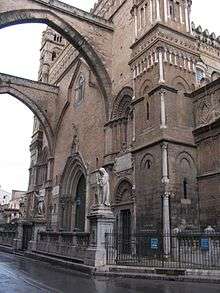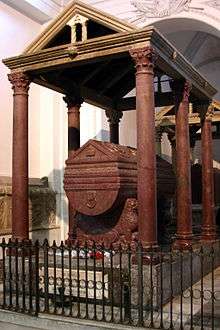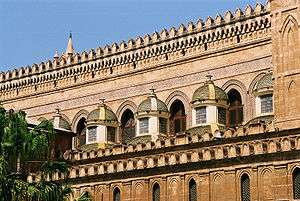Palermo Cathedral
| Metropolitan Cathedral of the Assumption of Virgin Mary Cattedrale metropolitana della Santa Vergine Maria Assunta | |
|---|---|
 Palermo Cathedral | |
| Basic information | |
| Location | Palermo, Italy |
| Geographic coordinates | 38°06′52″N 13°21′22″E / 38.11444°N 13.35611°ECoordinates: 38°06′52″N 13°21′22″E / 38.11444°N 13.35611°E |
| Affiliation | Roman Catholic Church |
| Province | Archdiocese of Palermo |
| Ecclesiastical or organizational status | Cathedral |
| Status | Active |
| Architectural description | |
| Architectural type | Church |
| Architectural style | Norman, Moorish, Gothic, Baroque, Neoclassical |
| Groundbreaking | 1185 |
| Completed | 18th century |
Palermo Cathedral is the cathedral church of the Roman Catholic Archdiocese of Palermo, located in Palermo, Sicily, southern Italy. It is dedicated to the Assumption of the Virgin Mary. As an architectural complex, it is characterized by the presence of different styles, due to a long history of additions, alterations and restorations, the last of which occurred in the 18th century.
History

The church was erected in 1185 by Walter Ophamil (or Walter of the Mill), the Anglo-Norman archbishop of Palermo and King William II's minister, on the area of an earlier Byzantine basilica. By all accounts this earlier church was founded by St. Gregory and was later turned into a mosque by the Saracens after their conquest of the city in the 9th century. Ophamil is buried in a sarcophagus in the church's crypt. The medieval edifice had a basilica plan with three apses, of which only some minor architectural elements survive today.
The upper orders of the corner towers were built between the 14th and the 15th centuries, while in the early Renaissance period the southern porch was added. The present neoclassical appearance dates from the work carried out over the two decades 1781 to 1801, and supervised by Ferdinando Fuga. During this period the great retable by Gagini, decorated with statues, friezes and reliefs, was destroyed and the sculptures moved to different parts of the basilica. Also by Fuga are the great dome emerging from the main body of the building, and the smaller domes covering the aisles' ceilings.
Overview
The main façade is on the Western side, on the current Via Bonello, and has the appearance set in the 14th and 15th centuries. It is flanked by two towers and has a Gothic portal surmounted by a niche with a precious 15th-century Madonna. Two lintelled ogival arcades, stepping over the street, connect the façade to the bell tower in the front, annexed to the Archbishops Palace. This has a squared appearance adorned in the upper part by a fine crown of smaller belfries and small arcades.
The right side has outstretching turrets and a wide portico (the current entrance) in Gothic-Catalan style, with three arcades, erected around 1465 and opening to the square. The first column on the left belonged to the original basilica and the subsequent mosque, as testified by the Qur'an verse carved on it. The carved portal of this entrance was executed in the period 1426 to 1430 by Antonio Gambara, while the magnificent wooden leaves are by Francesco Miranda (1432). The mosaic portraying the Madonna is from the 13th century, while the two monuments on the walls, works of the early 18th century, represents King Charles III of Bourbon and Victor Amadeus II of Sardinia, the latter of which was crowned here with his wife Anne Marie d'Orléans in December 1713.
The area of the apse, enclosed by the turrets and grandly decorated on the external walls, is part of the original 12th-century building, while the more modern part of the church is the left side, which has an early 16th-century portal by Antonello Gagini. The South-Western façade, looking at the Archbishop Palace, dates from the 14th to 15th centuries.

The interior has a Latin cross plan, with a nave and two aisles divided by pilasters. In the first two chapels of the right aisle are the tomb of emperors and royal figures moved here in the 18th century from their original sites (mostly from the basilica itself). Here are the remains of Emperor Henry VI, his son Frederick II, as well as those of Peter II of Sicily. A Roman sarcophagus is the tomb of Constance of Aragon, Frederick's wife. Under the mosaic baldachins are the tombs of Roger II, the first King of Sicily, and his daughter Constance. The last two were once located in the transept of the Cathedral of Cefalù.

The Sacrament chapel, at the end of the left aisles, is decorated with precious stones and lapislazuli. To the right, in the presbytery, is the chapel of Saint Rosalia, patron of Palermo, closed by a richly ornamental bronze gate, with relics and a 17th-century silver urn which is object of particular devotion.

The 1466 Gothic-Catalan style wooden choir and the marble remains of the Gagini's retable (removed during the 18th-century alterations) are also precious, as well as a marble statue of the Madonna with Child by Francesco Laurana and pupils (1469[1]), a 13th-century polychrome Crucifix by Manfredi Chiaramonte, the holy water stoup on the fourth pilaster (by Domenico Gagini) and the Madonna della Scala by Antonello Gagini, on the high altar of the new sacristy. The Relics Chapel contains the relics of St. Christina, St. Ninfa, St. Cosma, St. Agatha and St. Mamilianus, first patron of Palermo.

The crypt, accessed from the left side, is an evocative room with cross vault supported by granite columns, housing tombs and sarcophagi of Roman, Byzantine and Norman ages. People buried here include archbishops Walter Ophamil, the church's founder, and Giovanni Paternò, patron of Antonello Gagini who sculpted the image on his tomb.
The Cathedral Treasury contains goblets, vestments, monstrances, a 14th-century breviary and the famous Crown of Constance of Sicily, a golden tiara found in her tomb in 1491.
The Cathedral has a heliometer (solar "observatory") of 1690, one of a number built in Italy in the 17th and 18th centuries. The device itself is quite simple: a tiny hole in one of the minor domes acts as Pinhole camera, projecting an image of the sun onto the floor at solar noon (12:00 in winter, 13:00 in summer). There is a bronze line, la Meridiana on the floor, running precisely N/S. The ends of the line mark the positions as at the summer and winter solstices; signs of the zodiac show the various other dates throughout the year.
The purpose of the instrument was to standardise the measurement of time and the calendar. The convention in Sicily had been that the (24-hour) day was measured from the moment of sun-rise, which of course meant that no two locations had the same time and, more importantly, did not have the same time as in St. Peter's Basilica in Rome. It was also important to know when the Vernal Equinox occurred, to provide the correct date for Easter. On the belltowers there were six medieval bells.
17th and 19th century renovations
The church is composed of different styles, in the following centuries it underwent various changes. The last was at the end of the 18th century, when it radically remade the interior designed by Ferdinando Fuga.
In 1767, the archbishop Filangieri had entrusted to Ferdinand the restoration of the building. The work began only in 1781, carried out not by Ferdinand but by palermo Joseph Venanzio Marvuglia and lasted until the 19th century.
The reworking of the Marvuglia were in reality much more invasive and radical than the projects of the Florentine architect, who thought instead of keeping, at least in part, the complex of longitudinal aisles and the original wooden ceiling. The restoration intervened to change the original appearance of the complex, providing the church of the characteristic but discordant dome, performed according to the designs of Ferdinando Fuga.[2]
Kings crowned and buried in the cathedral
In this cathedral, synthesis of history and art of the last millennium in Sicily, in addition to the Norman kings were also crowned Vittorio Amedeo II of Savoy and Carlo III of Bourbon.
In the right aisle, the first and second chapel, communicating with one another, they preserve the imperial and royal tombs of the Normans, those of Frederick II and father of Henry VI.
The sarcophagus of Frederick II is surmounted by a canopy with porphyry columns and the urn is supported by two pairs of lions, together with those of Federico II were also preserved the remains of Peter II of Aragon. Other tombs are those of Constance of Aragon (1183-1222), sister of the king of Aragon, the wife of Frederick II, William, duke of Athens son of Frederick III of Aragon, and of the empress Constance d'Altavilla, daughter of Roger II and mother of Federico II.[3]
The treasure of the cathedral
The "treasure of the cathedral", which is composed of sacred vestments from the 16th and 18th centuries, frontals, monstrances, chalices, a breviary miniato of the 15th century and the tiara gold Constance of Aragon. Other precious objects, enamels, embroidery and jewelry, are exposed in central message boards such as for example the breviary parchment of the 1452 coat of arms with an Archbishop Simon from Bologna. The system of bells currently mounted is composed of eight elements assembled with the ambrosian.[4]
Notes
- ↑ The sculpture is commonly known as Madonna Libera Inferni ("free from Hell"). It received this name in 1576, when Pope Gregory XIII gave indulgence for the Purgatory's souls to the altar in which it is placed. The sculpture was intended for the church of Monte San Giuliano in Trapani, but remained here as the Palermitani refused to deprive themselves of such a beautiful art work.
- ↑ Enciclopedia universale, pp.32-34.
- ↑ Enciclopedia universale, pp.35-37
- ↑ Enciclopedia universale, p. 45
See also
References
- Palermo, in Enciclopedia universale, Rizzoli, Milano 1990.
- Patrizia Fabbri, Palermo e Monreale, Bonechi, 2005.
- Sicily and Its Islands, 1993 - Ugo La Rosa Publisher
| Wikimedia Commons has media related to Cattedrale di Palermo. |